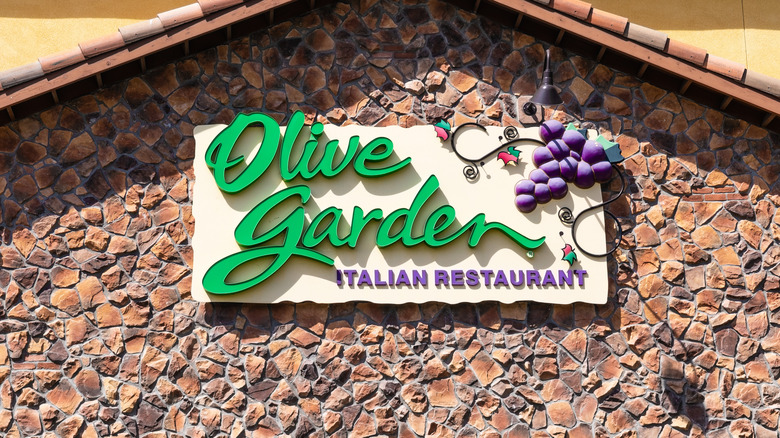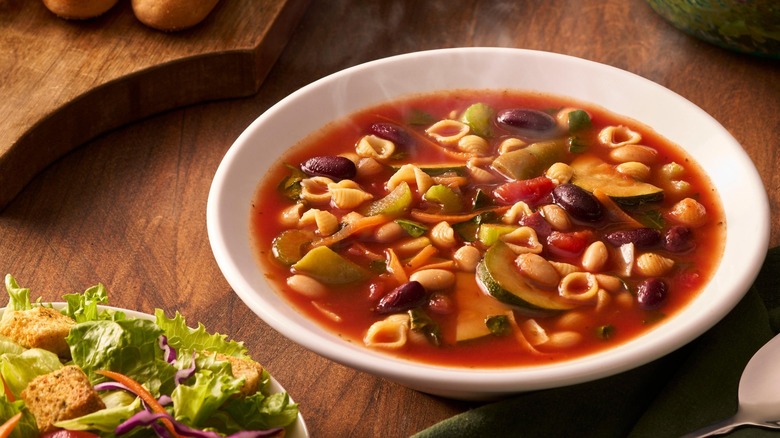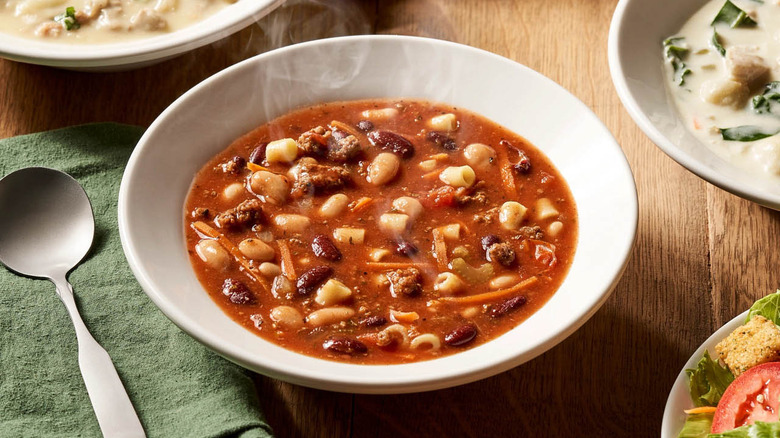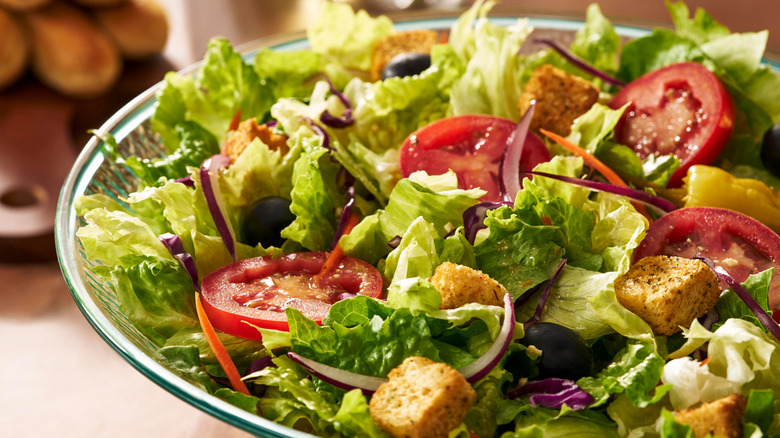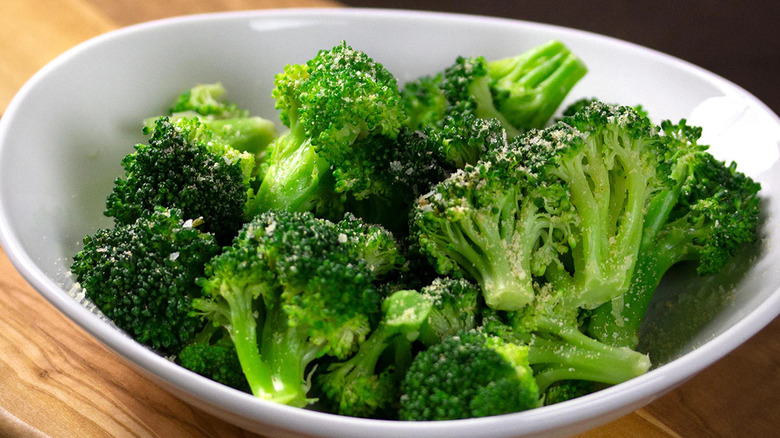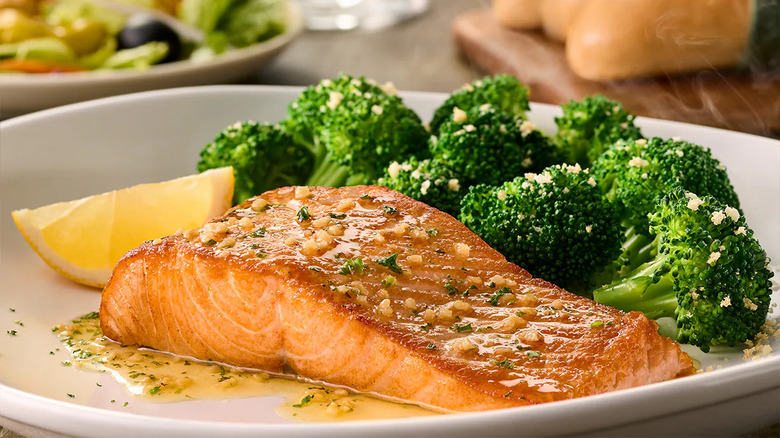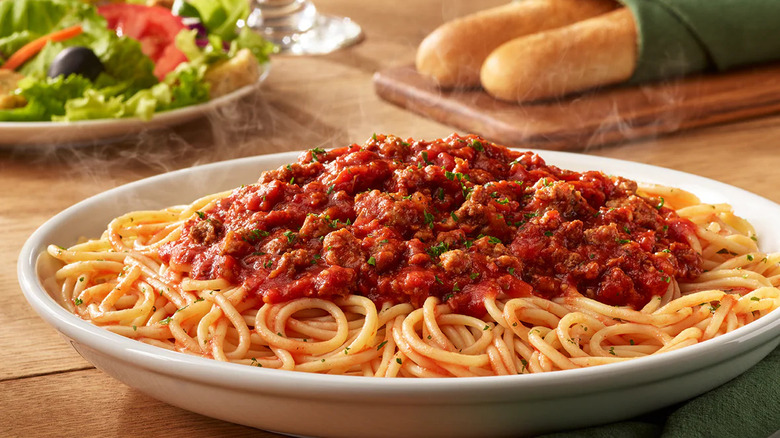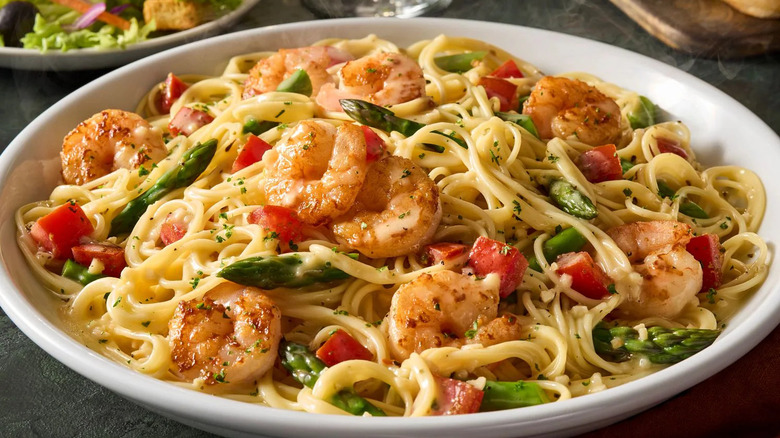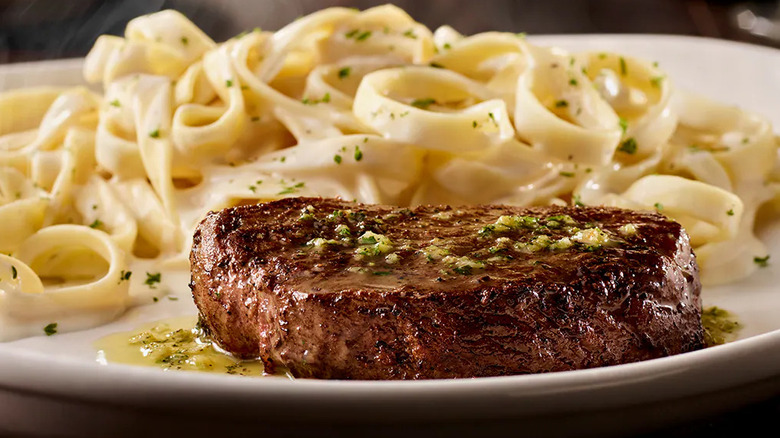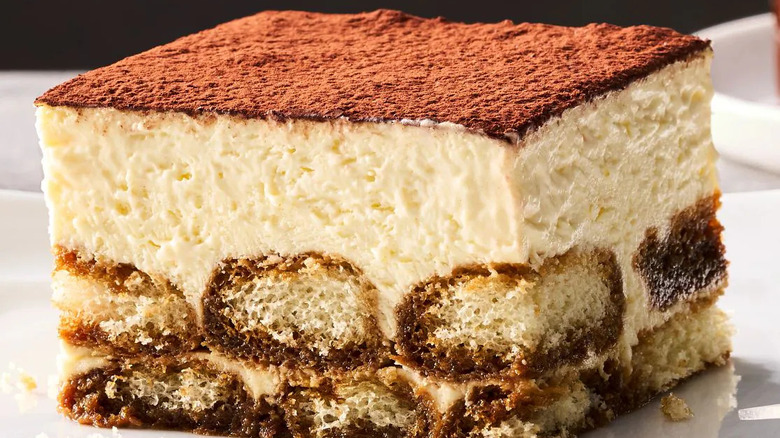12 Healthiest Menu Items You Can Get At Olive Garden
With its menu of pasta, heavy cream sauces, and never-ending soup, salad, and breadsticks, Olive Garden doesn't earn top spots on lists ranking healthy restaurants. Many people go here to overindulge and aren't apologetic about it. This Italian-themed restaurant was the 1982 brainchild of General Mills, which expanded the chain to 145 locations within seven years. Darden Restaurants took over in 1995 — a company that also owns Red Lobster, Capital Grille, and other well-known chains, so you'll sometimes see these eateries near an Olive Garden.
There are close to 900 Olive Garden restaurants worldwide. (One can only imagine how many pounds of pasta get served each year!) The Tuscany-themed interiors and architecture are appealing, the prices are reasonable, and there are tasty wines. The menu is what one expects at an Italian-American eatery. Some locations offer delivery, too.
Olive Garden's appetizers are (mostly) fried and creamy choices like mozzarella sticks, spinach-artichoke dip, and fried ravioli. On the menu, cheese is everywhere. The only fruit on the dessert menu is the strawberry topping on the cheesecake and cream cake. So many of the items have sky-high fat and salt content, but this is not unusual at popular chain restaurants. Fortunately, Olive Garden has a decent selection of healthy picks, so here are a dozen options to order next time you're in the mood to eat out with nutrition in mind.
Minestrone soup
Olive Garden has a few choices for its unlimited soups and its minestrone is one of the healthiest. This vegan version of the traditional Italian vegetable soup has tomato-based broth, beans, fresh veggies, and small, shell-shaped pasta. In a La Cucina Italiana post, nutritionist Valentina Schirò claimed that minestrone is packed with nutrients, vitamins, and antioxidants — the more vegetables, the better!
The soup is quite filling, thanks to its beans, which boast a high fiber content. Beans also contain potassium and magnesium, which have detoxifying properties. When eaten regularly, beans have anti-inflammatory properties and keep the intestines working as they should. According to Olive Garden's Nutritional Menu, one serving of this minestrone contains 1 gram of fat, 810 mg of sodium, 4 grams of fiber and sugar, and 5 grams of protein. The only concern here is its salt content. The FDA recommends a maximum of 2,300 mg daily, making that soup about one-third of the recommended daily dose. Still, there's a good amount of fiber and protein, so it's kind of a tradeoff.
Pasta e fagioli soup
The Italian word fagioli translates to beans in English. In Italy, pasta e fagioli has traditionally been made with pork, beans, an option of broth, and pasta. Olive Garden's second bean-based soup goes by this name and contains ground beef and red and white beans. It also has small, tube-shaped pasta and fresh tomatoes. This can be a nice, hearty start to a meal or be an entree to enjoy when it's cold outside.
This soup has 5 grams of fat — that's three more than the minestrone, so it likely comes from the ground beef. It also has 15 grams of cholesterol, 16 carbs, 3 grams of fiber, and surprisingly, 710 mg of sodium. (That's less salt than the minestrone, hmmm?) The beef also ups the protein content to 8 grams. Olive Garden's other two soups are Zuppa Toscana made with sausage, and chicken and gnocchi. Both of these are cream-based and the latter has 11 grams of fat and 1290 mg of sodium per serving. So minestrone and pasta e fagioli are two healthier soup choices.
Now, let's move on to the next course!
House salad
Unlimited salad got the Olive Garden brand off to a strong start, so we think it'll always be on the menu. Salads covered in thick, creamy dressings can have high-fat contents and drown out the taste of the vegetables; but at Olive Garden, the salad has its signature or low-fat Italian dressing on the side. The regular has 8 grams of fat and 520 mg of sodium and the other contains 2 grams of fat and 410 mg of sodium. It's hard to calculate the exact amount of sodium since the company's nutrition info doesn't show the serving sizes. So if you're trying to be careful, use this old trick: Dip your fork's tongs into the dressing and then spear the vegetables with it. Olive Garden's dressings are nice and savory so you won't need to use too much.
This salad is the only one on the menu and is pretty basic. It features lettuce, tomato slices, red onion, and croutons. However, you can request to have those bread cubes left out. It also comes with two breadsticks. Would this salad constitute a meal? You could pair it with soup for lunch but it wouldn't make a filling dinner. Still, a green salad before an Italian meal is always a good thing. Soup, salad, and two breadsticks come with some of the entrees and you can get unlimited of all three for around $9.99.
Broccoli
This might be the healthiest item on the entire Olive Garden menu and its only vegetable side dish. (The other two sides are grilled chicken and meatballs and those aren't technically sides, are they?) You can add the broccoli to a pasta dish or swap it out for a heavier side if you're counting carbs. The green veggie is dusted with a bit of garlic and parmesan cheese.
Broccoli is an unquestionably healthy food and there are loads of scientific data to support that claim. The USDA shows that one cup of chopped broccoli contains about ⅓ of a gram of fat, 2.57 grams of protein, and 2.37 grams of fiber. It's also high in calcium, vitamin C, and other nutrients. The leafy green is a cruciferous vegetable, belonging to the cabbage family. These hearty veggies are also thought to fight breast and prostate cancer, help the immune system, and prevent DNA damage. Those are pretty lofty claims! While there are no guarantees that diet can prevent illnesses, the consensus is broccoli is a net positive for your health. It also provides some bright color next to a pile of pale pasta and red tomato sauce.
Herb-grilled salmon
Broccoli also stars in Olive Garden's herb-grilled salmon dish, which is a gluten-sensitive entree. It has 29 grams of fat and 1,170 mg of sodium: However, we're not sure if those numbers include the garlic and parmesan broccoli that it comes with as a side. So how do you figure this one out? NutritionValue.org posts that 3 ounces of plain cooked salmon has 11 grams of fat and 52 mg of sodium. Assuming that an average restaurant-sized portion of salmon is between 5-7 ounces, Olive Garden's portion might have 22 grams of fat when uncooked. The extra sodium and fat content probably comes from two old friends: the salt shaker and butter.
Still, this is a healthy entree because salmon is so heart-healthy. SafeBeat recognizes that it's a superfood — even though the fat content is relatively high, these are good fats. Salmon has loads of omega-3 and -6 fatty acids and is high in protein, B12, potassium, riboflavin, and other nutrients. This source also claims that salmon improves cardiovascular health and helps your brain.
Spaghetti with meat sauce
Heading over to the meat department, we now look at this staple selection from Olive Garden's menu: spaghetti with meat sauce. This basic pasta dish's sauce is tomato-based and enhanced with diced tomatoes, beef, and sausage. We also want to point out that it's a great deal: The $13.99 price includes soup or salad and two breadsticks.
This popular entree has 22 grams of fat, 1050 mg of sodium, 85 carbs, and 17 grams of sugar. You'll also get 4 grams of fiber and 26 grams of protein from this dish. Also, it's a healthier option than Olive Garden's spaghetti with meatballs: That signature dish has 62 grams and 2110 mg of sodium. Yes, we know how delicious meatballs are, but if you're trying to cut back on sodium levels, just pretend that the meatballs were already broken up for you! The taste is pretty much the same with less beef in the mix.
Shrimp scampi
Olive Garden's shrimp scampi has a light garlic sauce, asparagus tips, and small pieces of tomatoes served atop a bed of pasta. We listed it here because shrimp is a good source of protein and its nutritional value is not canceled out from deep frying. Tufts University nutrition science professor Alice H. Lichtenstein, D.Sc. told Consumer Reports that this shellfish is extremely nutritious and contains magnesium, calcium, and vitamins. But it also contains a high percentage of selenium, which is known to help with inflammation and immune response support. Shrimp is low in saturated fat but high in cholesterol. If you're monitoring your cholesterol, you'll want to limit your intake.
Many shrimp scampi recipes use a whole stick of butter but lighter versions use a few tablespoons and olive oil instead. Olive Garden's version is a heart-healthier version that doesn't rely on excess butter to amp up the taste. It has 20 grams of fat, 960 mg of sodium, and 54 grams of carbs. As for the positives, the scampi also has 29 grams of protein, 4 grams of fiber, and only 5 grams of sugar. Compare this to Olive Garden's shrimp alfredo which has 91 grams of fat and 1620 mg of sodium, and you'll see why this is the healthier choice.
Grilled chicken margherita
The word Margherita translates to daisy in English but you won't find these pretty white flowers in this entree. Olive Garden's beautifully plated version gets its flavor from lemon, garlic, and basil pesto. The dish comes with broccoli instead of pasta. We chose this boneless chicken dish because it's grilled and loaded with veggies and herbs instead of creamy pasta. The boneless chicken has a mozzarella topping and a light lemon-garlic sauce.
Grilled and sauteed foods don't absorb fat as fried foods do, which contributes to the healthiness of this dish. The dish has a lower carb count because there's no starch on the side. Chicken has a ton of protein, too. According to myfitnesspal, just 1 ounce of boneless, skinless chicken breast has 9.1 grams of protein, and we're sure that this grilled chicken margherita has more than that. Still, it's high in sodium, clocking in at 1930 mg per serving. We're thinking that the high salt content comes from that delicious basil pesto and mozzarella, so you can ask for the pesto to be served on the side and take off a little bit of the cheese if you're on a low-sodium diet.
Kids grilled chicken with pasta
For your pint-sized eaters, Olive Garden's kids grilled chicken with pasta is a nice-sized kids' meal that comes with broccoli or grapes and a glass of 1 percent milk. But if your younger dinner guests want never-ending soup, salad, and pasta, that's not included and must be ordered and paid for separately. A similar entree is also available for the over-age-12 set, and you get a larger portion but will pay a bit more. Both can be ordered with gluten-free rotini or regular pasta.
This seems to be a low-fat, high-protein meal but the nutritional information isn't clearly spelled out on the website or nutritional menu. It's a little harder to figure out because the dish can be ired with different kinds of pasta and sides. We'll assume that it has a high sodium count like most of Olive Garden's other offerings, but this isn't the worst thing your kid will ever eat. Other kids' menu picks include the usual suspects — mini pizza with French fries, chicken fingers, mac & cheese, and ravioli.
6 oz. sirloin served with broccoli
This entree is also offered with a side of fettucini alfredo. However, to make the dish healthier, we opted for the broccoli side to cut down on the carb, dairy, and fat content in the meal. Meat has a bad reputation health-wise because consuming too much of it can lead to problems like diabetes and heart disease. Meat is high in protein but adults only need 50 grams of protein per day, according to the Mayo Clinic. We don't recommend having steak every day based on those dietary guidelines, but you can treat yourself now and again to this reasonably-priced portion. (That is, if it's okay with your doctor, too!)
But it's worth noting that this sirloin gets an extra shot of fat from garlic butter. You can ask for the butter to be served on the side or left out entirely. So are you ready for the breakdown? This entree has 62 grams of fat, 1840 mg of sodium, 2 grams of dietary fiber, and wait for it – 57 grams of protein.
Cheese ravioli with marinara sauce
A ton of cheese can clog up the arteries, but this dish isn't that bad if you order it with marinara instead of meat sauce. The plump pasta pieces are filled with different cheeses, topped with sauce, and covered in oven-browned mozzarella. But is cheese healthy? Yes and no — generally, cheese is high in calcium, protein, and vitamin A, but the nutritional amounts vary depending on the cheese. We don't know what kind Olive Garden uses because it's a blend. Full-fat dairy food like cheese is high in sodium and saturated fat, but like meat, is healthy in moderation.
One serving of Olive Garden's marinara sauce has 80 grams of fat, 17 grams of carbs, 1280 mg of sodium, 10 grams of sugar, and 4 grams of protein. Salt and sugar are frequently added to tomato sauces to cut the acidity. If you check tomato sauce jar labels, you'll see that they sometimes have a lot. Served with marinara, this ravioli has 38 grams of fat, 2370 mg of sodium, 8 grams of sugar, and 41 grams of protein. The cheese ravioli with meat sauce has 46 grams of fat, 2190 mg of sodium, 11 grams of sugar, and 50 grams of protein.
Wait, you think that's over the top? Olive Garden's ravioli carbonara has 104 grams of fat and 2660 mg of sodium because it's made with cream sauce and bacon.
Tiramisu
Out of the six desserts on Olive Garden's menu, the tiramisu seems to be the least hazardous to one's health. The restaurant serves its traditional version, with ladyfingers on the bottom, creamy custard in the middle, and espresso powder on top. Tiramisu is an Italian word that means "pick me up," and this makes sense because the dish uses espresso as an ingredient. Just don't eat too much of it before going to bed, or you might be up all night!
You'll find different versions of it at Italian restaurants, but Olive Garden's version is a solid one. The other desserts on the menu are somewhat heavier and include Italian doughnuts and chocolate brownie lasagna. One serving of this tiramisu has 27 grams of fat, 125 mg of sodium, 54 carbs, and 35 grams of sugar. That amazing-looking brownie has almost twice as much fat, more than four times as much sodium, and 103 grams of sugar per serving. Does this mean that you should deprive yourself of dessert? Again, the key is moderation. Indulge once in a while or split it with someone (as long as your doctor doesn't recommend otherwise).
